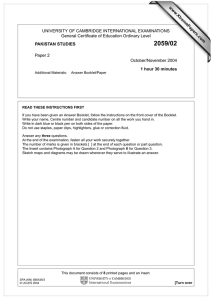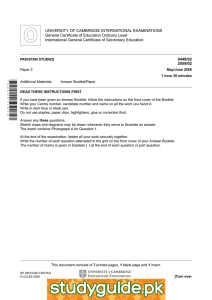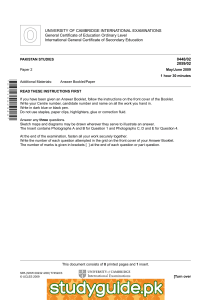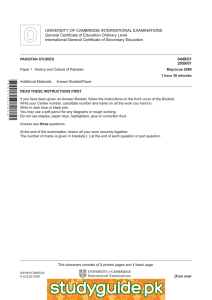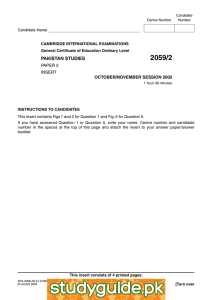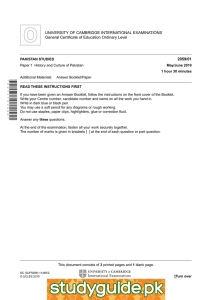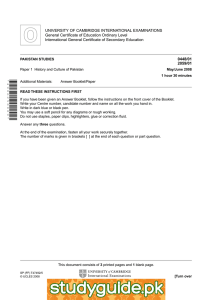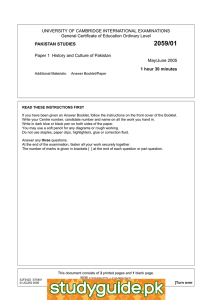2059/02
advertisement
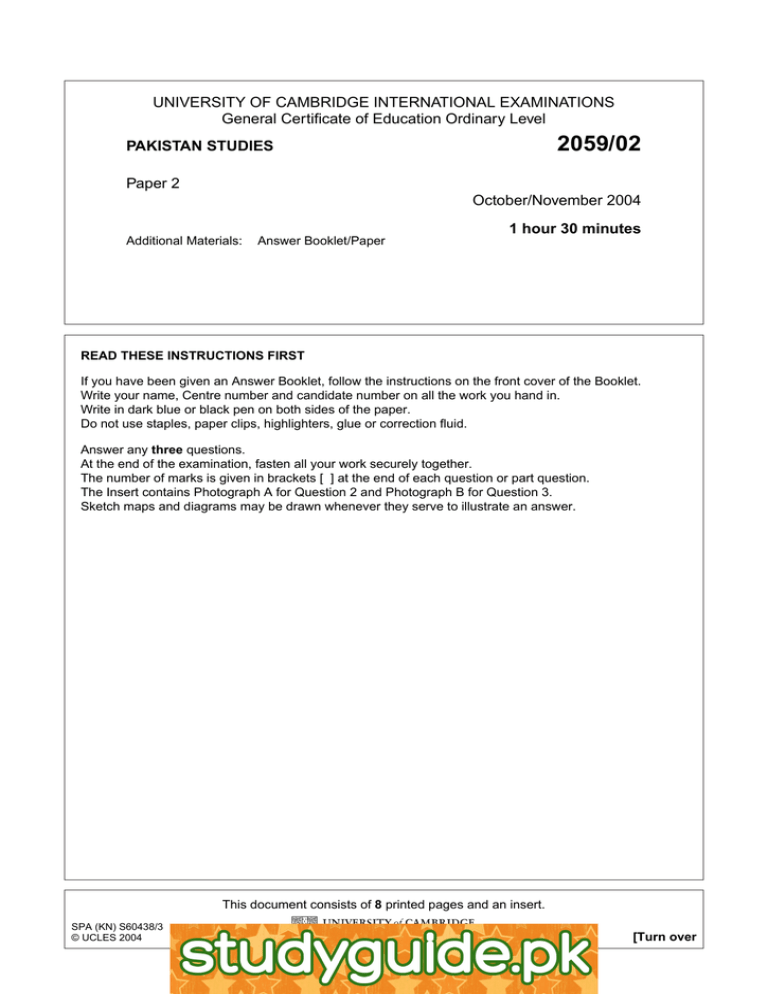
UNIVERSITY OF CAMBRIDGE INTERNATIONAL EXAMINATIONS General Certificate of Education Ordinary Level 2059/02 PAKISTAN STUDIES Paper 2 October/November 2004 1 hour 30 minutes Additional Materials: Answer Booklet/Paper READ THESE INSTRUCTIONS FIRST If you have been given an Answer Booklet, follow the instructions on the front cover of the Booklet. Write your name, Centre number and candidate number on all the work you hand in. Write in dark blue or black pen on both sides of the paper. Do not use staples, paper clips, highlighters, glue or correction fluid. Answer any three questions. At the end of the examination, fasten all your work securely together. The number of marks is given in brackets [ ] at the end of each question or part question. The Insert contains Photograph A for Question 2 and Photograph B for Question 3. Sketch maps and diagrams may be drawn whenever they serve to illustrate an answer. This document consists of 8 printed pages and an insert. SPA (KN) S60438/3 © UCLES 2004 [Turn over www.xtremepapers.net 2 The Environment of Pakistan 1 (a) Study the map of Pakistan, Fig. 1. mm 350 Nok Kundi 300 250 200 B A N 150 B 100 C 50 E 0 Murree J FMAM J J A SOND E Nok Kundi mm 350 D Murree 300 250 200 150 0 100 km 200 50 Arabian Sea 0 Key International boundary Provincial boundary Rivers Mountain range Desert Settlement Fig. 1 © UCLES 2004 2059/02/O/N/04 www.xtremepapers.net J FMAM J J A SOND 3 On your answer paper: (i) state the number of degrees north of latitude A (Murree is 34°N), [1] (ii) name the mountain range B, [1] (iii) name the river C, [1] (iv) name the desert D, [1] (v) name city E. [1] (b) Study the rainfall graph for Murree located on the map, Fig. 1. (i) What is the total rainfall for the period July-August? [1] (ii) Explain the high rainfall total for the period July-August. [5] (iii) Describe the amount and pattern of Murree’s rainfall from December to March. [3] (iv) Explain why Murree has rainfall in winter. [3] (v) What type of rainfall does Murree receive in May-June and October-November and how is it formed? [4] (c) Study the rainfall graphs for Nok Kundi and Murree located on the map, Fig. 1. (i) How much more rainfall does the driest month at Murree receive than the wettest month at Nok Kundi? [1] (ii) Murree has as much rain in its driest month as Nok Kundi receives in a whole year. Why is the area in which Nok Kundi is situated so dry? [3] © UCLES 2004 2059/02/O/N/04 www.xtremepapers.net [Turn over 4 2 Study Fig.2. N Key International boundary Provincial boundary Rivers Area with natural forests 0 km 200 Irrigated forests Arabian Sea Fig. 2 (a) Describe the distributions of both the areas with natural forests and the irrigated forests shown on Fig.2. [4] © UCLES 2004 2059/02/O/N/04 www.xtremepapers.net 5 (b) There has been deforestation within the areas with natural forests. How has this caused problems for: (i) communications in the mountain areas, [3] (ii) farming on valley floors and plains, [3] (iii) hydro-electric (hydel) power supplies? [3] (c) Linear plantations are common in many parts of Pakistan. (i) What are linear plantations and where are they found? [4] (ii) Explain the purposes of linear plantations. [4] (d) Photograph A (insert) shows a furniture workshop in Chitral which is in an area with natural forests. Describe the features of this workshop and the characteristics of the type of industry shown. [4] 3 (a) On 15th April 2002 a heavy thunderstorm occurred in the catchment area of the River Gomal in the Sulaiman mountains. Photograph B (insert) was taken on 17th April on the piedmont plain east of these mountains. It shows the Gomal flood plain which was being prepared for farming, making use of this natural inundation (flooding). (i) Describe the scene shown. [4] (ii) How does farming which depends on natural inundation (flooding) like this differ from farming that depends on irrigation? [4] (b) Away from the Gomal flood plain, in those areas which the flood waters cannot reach, barani farming is practised. Give the main characteristics of barani farming and name two crops grown in this way. [6] (c) Rice is one of Pakistan’s major crops. (i) Why is rice a kharif crop? [2] (ii) Why is rice not grown in areas which only practise barani farming? [2] (iii) Explain why rice growing is important in north-east Punjab and in the northern Lower Indus Plain of Sindh. [5] (iv) Name the main type of rice that is exported and name the country which was a part of Pakistan and now imports rice from Pakistan. [2] © UCLES 2004 2059/02/O/N/04 www.xtremepapers.net [Turn over 6 4 The sketch map, Fig. 3, shows the location of important industrial centres in north-east Punjab and their main industries. Mangla Reservoir N Jh el um Azad Kashmir Gujrat Sambrial DP EPZ Sialkot b na e Ch Gujranwala vi Ra Shekhupura INDIA Chiniot bad Lahore la isa DP Fa DP Jaranwala 0 15 Key Boundary with Kashmir and India Industrial centre Power station Rivers DP Main road Railway EPZ Dry Port Export Processing Zone National electricity grid Gas pipeline Airport Fig. 3 © UCLES 2004 2059/02/O/N/04 www.xtremepapers.net km 45 60 7 (a) With the help of Fig. 3 and your own knowledge describe the factors that have encouraged the growth of industries in this area. [7] (b) Sialkot is a major industrial centre for export goods. (i) Sports goods and surgical instruments are very successful industries in Sialkot. With the help of Fig. 3 and your own knowledge explain why this is so, despite the fact that most of their raw materials have to be imported. [3] (ii) About 99% of Sialkot’s industries export their products or supply the exporting factories. Why are exports very important for the development of Pakistan? [5] (iii) Since 2000 the Sialkot Export Processing Zone has been in the process of development at Sambrial and a new airport is being built by the Sialkot Chamber of Commerce. How will these developments help the expansion of industry? [5] (c) What factors should be considered when choosing the site for a new airport like the one being built at Sialkot? [5] © UCLES 2004 2059/02/O/N/04 www.xtremepapers.net [Turn over 8 5 (a) Balochistan: • occupies 43.5% of Pakistan • has a total population of 6.5 million • has 5% of the total population of Pakistan • has an average population density of 19 per square kilometre (i) Amongst the provinces of Pakistan where does Balochistan rank in terms of size? [1] (ii) Amongst the provinces of Pakistan where does Balochistan rank in terms of its total population? [1] (iii) Describe in no more than two words the average population density of Balochistan. [1] (b) The map, Fig. 4 shows the densities of population in Balochistan. N Key Z International boundary Provincial boundary Coastline A Population density per km2 B 101-200 51-100 11-50 Z fewer than 11 0 km 200 Arabian Sea Fig. 4 (i) Explain why the area marked A has the highest density of population in Balochistan. [6] (ii) Explain why large areas of Balochistan have fewer than 11 people per square kilometre. [7] (iii) The area marked B is part of the Lower Indus Plain. Explain the density of population in this area. [4] (iv) Why is it that in the area to the south-west of line Z–Z some permanent settlements do exist? [5] University of Cambridge International Examinations is part of the University of Cambridge Local Examinations Syndicate (UCLES), which is itself a department of the University of Cambridge. © UCLES 2004 2059/02/O/N/04 www.xtremepapers.net
